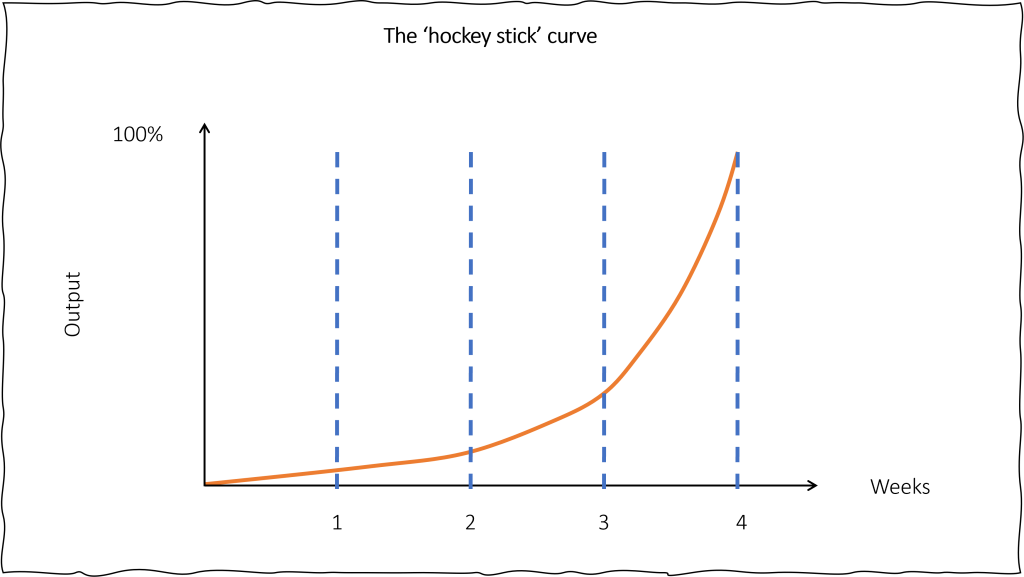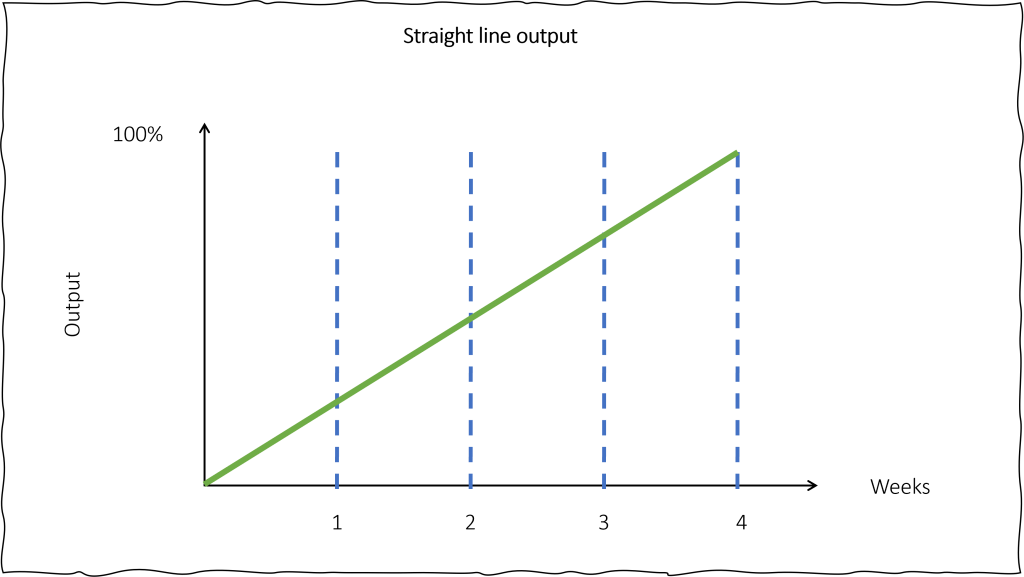Do you hate the pressure of the month end? That time of the month is a nightmare for many, trying to achieve deliveries with maximal effort. When I talk about avoiding ‘blood, sweat and tears’ around on time delivery this is what I mean.
OTIF, if you haven’t come across this term, stands for On Time In Full. It measures deliveries based on promises kept, as opposed to the percentage of items shipped on time. Good OTIF performance is usually considered to be 98%+.
A few times during the past month the topic of the hockey stick curve has come up. These conversations have been with businesses that have the exact problem highlighted above. OTIF performance is full of blood, sweat and tears! The last week of the month is as hectic as can be. All rules go out the window. Inter-departmental relationships get strained.
If you haven’t come across the term ‘the hockey stick curve’, let me explain using the diagram below:

The hockey stick is the shape of the curve. I may not have done it justice in this image, but you should get the idea.
During the first couple of weeks, the output isn’t as high as it should be. As the deadline of the month looms, activity ramps up and often corners get cut. The business often achieves its output, even with the stresses and strains. There is a major knock on effect however. During the next month the first couple of weeks are all about recovering from the previous month.
This recovery period leads straight back into the next hockey stick… OTIF performance suffers in the long term.
So, let me share with you some ideas to help you get away from this cycle, if you are experiencing the same effect.
Focus on regular wins
The period of a month is too long for many people to keep focus. Shorter time periods work better here, to improve delivery performance.
In short, good days lead to good weeks. Good weeks lead to good months… If you want a good year, you need to have good days most days.
Changing your focus means changing your management approach. This change hinges around your ability to change your perspective. At some points you will need to:
- Think strategy and map out the year ahead.
- Think resource and look at the quarter ahead.
- Think business plan and optimise the months’ workload.
- Think operations and support your teams to win every day.
Change your KPIs
If you are experiencing the hockey stick, then changing your metrics may help. Looking at the bullet points above, you may want to consider a range of delivery metrics.
If you are measuring output on a monthly basis, then consider daily or weekly metrics. When your team start to see the new scores, and you reinforce it, behaviours change.
This change, like most improvements, may not be comfortable. If you want the results, however, it is a journey you will need to take.
Change your discussions
When you change your approach, your conversations need to change also. Instead of focussing on output on a monthly basis, it needs to be daily. Instead of having different activities take place at the end of the month, you need a daily standard.
By different activities I am referring to:
- Effort applied.
- Organisation and planning.
- Scheduling and resourcing.
- Team working.
Many businesses are sloppy during the first couple of weeks of the month. As the period progresses, focus sharpens. Planning and scheduling improves and the team pull together. Why not do this from day one of the month?
The focus of this article is to remove the need for the first bullet point – increased effort. My goal for you is to come up with a way of working that blends improved planning and team work. The results should be achieving high on time delivery levels with the minimum level of effort.
Your team need to understand that each day is as important as the others. The importance of the month end needs to leave the mouths of those in your team and the wider business.
Aim for the straight line
Instead of the hockey stick curve, aim to achieve a straight line, as per the image below:

Every week should be more or less the same. The management routines should be more or less the same. Processes happen day in day out, regardless of the date in the month.
Managing your way away from the hockey stick curve takes effort and persistence. It will demand that your team to see the world in a different light, but the results are worth it.
And, if you aren’t in a production environment, think in a lateral manner. You can apply this approach to projects, objectives, reports, meetings… pretty much anything with a deadline.
Less hassle, happier customers, more control over your operations… why would you want to stay with the hockey stick?
If you want a system to help you consistently improve your OTIF performance then check out The OTIF Improvement System. This is the ready to use system that embraces the ideas put forward in this article.
